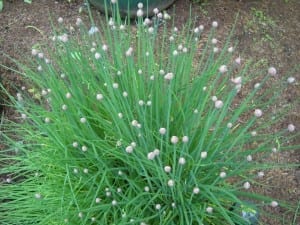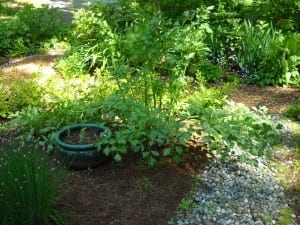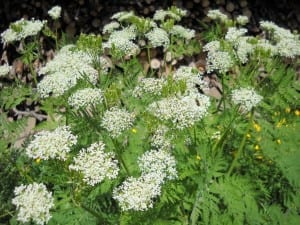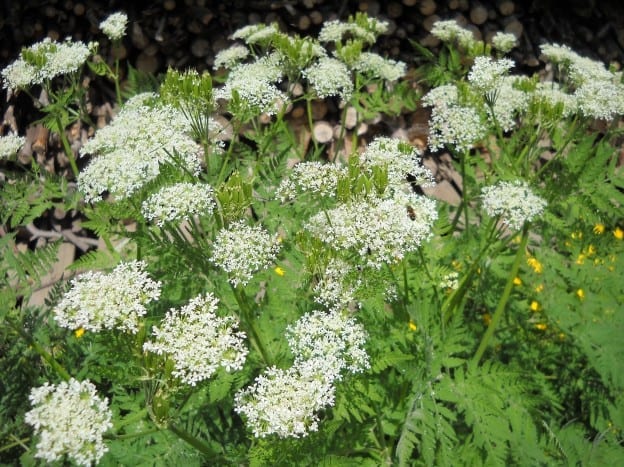 I spent a lovely hour in Jean’s garden Monday. It was delight filled to sit and feel the sun and the wind, hear the birds and the bees and see all the local flora dong their thing after collecting some pictures to show you what in happening to the herbs we have already covered.
I spent a lovely hour in Jean’s garden Monday. It was delight filled to sit and feel the sun and the wind, hear the birds and the bees and see all the local flora dong their thing after collecting some pictures to show you what in happening to the herbs we have already covered.
The chives are almost ready to pop with purple puff balls in the herb garden and the lovage is happily getting bigger and bigger, to the point it has trouble holding itself upright. I was the beneficiary of all that abundant growth and have several stocks to put into a smoked turkey soup I need to make soon.
 If you don’t have five acres to play in, it is still early enough in some parts of the country to find smaller plants to fill a herb planter with culinary options such as sage, thyme or rosemary to enjoy through the summer and into fall.
If you don’t have five acres to play in, it is still early enough in some parts of the country to find smaller plants to fill a herb planter with culinary options such as sage, thyme or rosemary to enjoy through the summer and into fall.
Choose species that enjoy similar growing environments when it comes to light and water. Or just plant the entire container with basil and find a sunny spot. Home made pesto sauce with garlic, nuts and olive oil will be extra satisfying when they come from your own garden.
The trip to the garden was initiated because the sweet cicely was in bloom and and I wanted to use it as a garnish for the rhubarb fool I will be posting later in the week.
Sweet cicely leaves are anise flavoured and a major ingredient in Aquavit and Chartreuse liquors. Cooking ( and eating ) the young roots is said to aid “those without courage”. It is a hardy perennial that does best in rich moist soil, preferably in a cool and shady location.
The leaves do not hold their flavour when dried so it is best to use fresh in salads and add to tart cooked fruits like rhubarb, gooseberries and some apples. The sweetness of the leaves will complement the tartness of the fruit.  Use sweet cicely to flavour dairy dishes such as rice pudding, yogurt and cream but also think along the lines of soups, stews, omelettes and wine if you are making your own.
Use sweet cicely to flavour dairy dishes such as rice pudding, yogurt and cream but also think along the lines of soups, stews, omelettes and wine if you are making your own.
The roots can be boiled as a vegetable. If you would like to store them, try candying them and using as a garnish on desserts or preserve in brandy. Native North Americans use sweet cicely as a digestive aid and anticeptic.
The stems are crisp and have a celery like flavour great for salads and stews.
The fruits which look like little seeds are aromatic and a nut flavoured when eaten young and green. They can be pickled for storing.
If you are wildcrafting, be sure you have sweet cicley and not hemlock, which in bloom can look very similar and is poisonous.
Do you have sweet cicely where you live? What do you do with it? Leave all suggestions, one click back on the Facebook page so we call learn please.
Bright Blessings!


